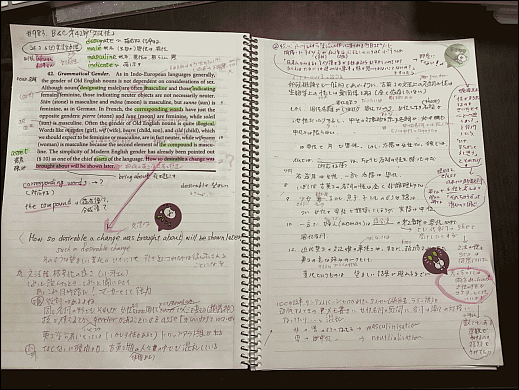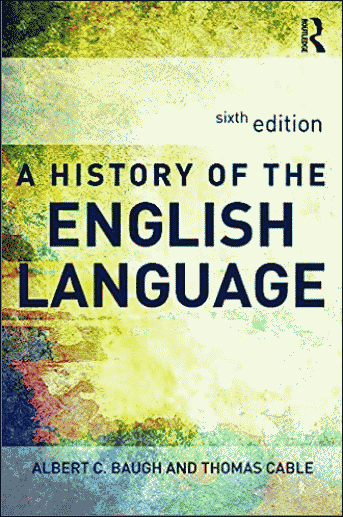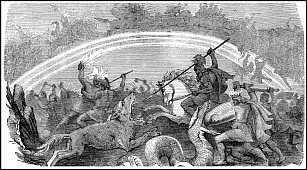2024-05-24 Fri
■ #5506. be to do 構文は古英語からあった [be_to_do][syntax][infinitive][auxiliary_verb][oe][impersonal_verb][construction][grammaticalisation]
英語には be to do 構文というものがある.be 動詞の後に to 不定詞が続く構文で,予定,運命,義務・命令,可能,意志など様々な意味をもち,英語学習者泣かせの項目である.この文法事項については「#4104. なぜ He is to blame. は He is to be blamed. とならないのですか? --- hellog ラジオ版」 ([2020-07-22-1]) で少し触れた.
では,be to do 構文の歴史はいかに? 実は非常に古くからあり,古英語でもすでに少なくとも「構文の種」として確認される.古英語では高頻度に生起するわけではないが,中英語以降では頻度も増し,現代的な「構文」らしいものへと成長していく.近代英語にかけては,他の構文とタグも組めるほどに安定性を示すようになった.長期にわたる文法化 (grammaticalisation) の1例といってよい.
先行研究は少なくないが,ここでは Denison (317--18) の解説を示そう.長期にわたる発達が手短かにまとめられている.
11.3.9.3 BE of necessity, obligation, or future
This verb too is a marginal modal, patterning with a to-infinitive to express meanings otherwise often expressed by modals. For Old English see Mitchell (1985: §§934--49), and more generally Visser (1963--73: §§1372--83). One complication is that the syntagm BEON + to-infinitive is used both personally [158] and impersonally [159]:
[158] Mt(WSCp) 11.3
. . . & cwað eart þu þe to cumenne eart . . .
. . . and said are(2 SG) you(2 SG) that (REL) to come are(2 SG)
Lat. . . . ait illi tu es qui uenturus es
'. . . and said: "Are you he that is to come?"'
[159] ÆLS I 10.133
us nys to cweðenne þæt ge unclæne syndon
us(DAT) not-is to say that you unclean are
'It is not for us to say that you are unclean.'
In Middle and Modern English this BE had a full paradigm:
[160] 1660 Pepys, Diary I 193.7 (5 Jul)
. . . the King and Parliament being to be intertained by the City today with great pomp.
[161] 1667 Pepys, Diary VIII 452.6 (27 Sep)
Nay, several grandees, having been to marry a daughter, . . . have wrote letters . . .
[162] 1816 Austen, Mansfield Part I.xiv.135.30
You will be to visit me in prison with a basket of provisions;
Visser states that syntagms with infinitive be are 'still current' (1963--73: §2135), but although there are a few relevant examples later than Jane Austen (1963--73: §§1378, 2135, 2142), most are of the fixed idiom BE to come, as in:
[163] But they may yet be to come.
まとめると,be to do 構文は古英語からその萌芽がみられ,中英語から近代英語にかけておおいに発達した.一時は他の構文とも組める統語的柔軟性を獲得したが,現代にかけてはむしろ柔軟性を失い,統語的には単体で用いられるようになり,現代に至る.
・ Denison, David. English Historical Syntax. Longman: Harlow, 1993.
2024-05-20 Mon
■ #5502. 注意すべき古英語の比較級・最上級 [superlative][comparison][adjective][adverb][suppletion][morphology][inflection][oe][i-mutation]
現代英語の形容詞・副詞の比較級・最上級には不規則なものがいくつかある.good -- better -- best や bad -- worse --worst などの補充法 (suppletion) を示すものが知られているが,これらは古英語にも存在した.むしろ古英語では現代よりも多くの不規則な比較級・最上級があった.Sweet's Anglo-Saxon Primer (19--20) より,注意すべきものを列挙する.
[ i-mutation を含む形容詞の比較級・最上級 ]
| Meaning | Positive | Comparative | Superlative |
|---|---|---|---|
| "old" | eald | ieldra | ieldest |
| "young" | ġeong | ġingra | ġingest |
| "long" | lang | lengra | lengest |
| "strong" | strang | strengra | strengest |
| "high" | hēah | hīerra | hīehst |
[ suppletion を含む形容詞の比較級・最上級 ]
| Meaning | Positive | Comparative | Superlative |
|---|---|---|---|
| "good" | gōd | betera, betra | betst |
| sēlra | sēlest | ||
| "bad" | yfel | wiersa | wier(re)st |
| "great" | miċel | māra | mǣst |
| "little" | lȳtel | lǣssa | lǣst |
[ 原級が副詞である形容詞の比較級・最上級 ]
| Meaning | Positive | Comparative | Superlative |
|---|---|---|---|
| "formerly" | (ǣr) | ǣrra | ǣrest |
| "far" | (feorr) | fierra | fierrest |
| "before" | (fore) | forma, fyrmest, fyr(e)st | |
| "near" | (nēah) | nēarra | nīehst |
| "outside" | (ūte) | ūterra | ūt(e)mest |
| ȳterra | ȳt(e)mest |
[ suppletion を含む副詞の比較級・最上級 ]
| Meaning | Positive | Comparative | Superlative |
|---|---|---|---|
| "well" | wel | bet | bet(e)st |
| sēl | sēlest | ||
| "badly" | yfle | wiers | wier(re)st |
| "much" | micle | mā | mǣst |
| "little" | lȳt | lǣs | lǣst |
・ Davis, Norman. Sweet's Anglo-Saxon Primer. 9th ed. Oxford: Clarendon, 1953.
2024-05-17 Fri
■ #5499. 古英語の数詞 [oe][numeral][voicy][heldio][link]
Sweet's Anglo-Saxon Primer (20--21) より古英語の数詞 (numeral) を挙げる.基数詞 (cardinal numbers) と序数詞 (ordinal numbers) の各々を列挙する.
| Cardinal | Ordinal | |
| 1(st) | ān | forma |
| 2(nd) | twā | ōþer |
| 3(rd) | þrēo | þridda |
| 4(th) | fēower | fēorþa |
| 5(th) | fīf | fīfta |
| 6(th) | siex | siexta |
| 7(th) | seofon | seofoþa |
| 8(th) | eahta | eahtoþa |
| 9(th) | nigon | nigoþa |
| 10(th) | tīen | tēoþa |
| 11(th) | en(d)leofon | en(d)leofta |
| 12(th) | twelf | twelfta |
| 13(th) | þrēo-tīene | þrēo-tēoþa |
| ... | ... | ... |
| 19(th) | nigon-tīene | nigon-tēoþa |
| 20(th) | twen-tiġ | twentigoþa |
| 30(th) | þrī-tiġ | þrītigoþa |
| 40(th) | fēower-tiġ | fēowertigoþa |
| 50(th) | fīf-tiġ | fīftigoþa |
| 60(th) | siex-tiġ | siextigoþa |
| 70 | hund・seofon-tiġ | |
| 80 | hund・eahta-tiġ | |
| 90 | hund・nigon-tiġ | |
| 100 | hund, hundred, hund・tēon-tiġ | |
| 110 | hund・endleofon-tiġ | |
| 120 | hund・twelf-tiġ | |
| 1000 | þūsend |
これまでも hellog や Voicy heldio で英語の数詞に関する話題を多々取り上げてきた.以下に主なコンテンツへのリンクを張っておく.
・ hellog 「#67. 序数詞における補充法」 ([2009-07-04-1])
・ hellog 「#68. first は何の最上級か」 ([2009-07-05-1])
・ hellog 「#69. second の世界の広がり」 ([2009-07-06-1])
・ hellog 「#646. billion の値」 ([2011-02-02-1])
・ hellog 「#647. million 以上の大きな単位」 ([2011-02-03-1])
・ hellog 「#1080. なぜ five の序数詞は fifth なのか?」 ([2012-04-11-1])
・ hellog 「#1823. ローマ数字」 ([2014-04-24-1])
・ hellog 「#2240. thousand は "swelling hundred"」 ([2015-06-15-1])
・ hellog 「#2285. hundred は "great ten"」 ([2015-07-30-1])
・ hellog 「#2286. 古英語の hundseofontig (seventy), hundeahtatig (eighty), etc.」 ([2015-07-31-1])
・ hellog 「#2304. 古英語の hundseofontig (seventy), hundeahtatig (eighty), etc. (2)」 ([2015-08-18-1])
・ hellog 「#2477. 英語にみられる20進法の残滓」 ([2016-02-07-1])
・ hellog 「#3104. なぜ「ninth(ナインス)に e はないんす」かね?」 ([2017-10-26-1])
・ hellog 「#3105. tithe と tenth」 ([2017-10-27-1])
・ hellog 「#4046. 歴史的に妙な ten の短母音」 ([2020-05-25-1])
・ hellog 「#4248. なぜ three と thirteen では r の位置が異なるのですか? --- hellog ラジオ版」 ([2020-12-13-1])
・ hellog 「#4429. 序数詞 third の d と fourth の th の関係」 ([2021-06-12-1])
・ heldio 「#10. third は three + th の変形なので準規則的」
・ heldio 「#419. 23 が「three and twenty」!?」
・ heldio 「#440. なぜ oneteen, twoteen ではなく eleven, twelve というの?」
・ heldio 「#442. 英語における12進法的発想」
・ heldio 「#443. 英語における20進法的発想」
・ Davis, Norman. Sweet's Anglo-Saxon Primer. 9th ed. Oxford: Clarendon, 1953.
2024-05-15 Wed
■ #5497. 「ゼロから学ぶはじめての古英語」 Part 6 with 小河舜さん and まさにゃん [voicy][heldio][masanyan][ogawashun][oe][oe_text][bede][christianity][anglo-saxon][st_augustine][hajimeteno_koeigo][hel_education][notice][popular_passage][history][literature]

5月9日(木)の夜,Voicy heldio にて「#1078. 「はじめての古英語」生放送 with 小河舜さん&まさにゃん --- Bede を読む (3)」をお届けしました.ライヴでお聴きの方々には,投げ込みのコメントや質問をいただきましてありがとうございました.
精読対象テキストは,前回に引き続き,Bede によりラテン語で著わされた『英国民教会史』 (Historia Ecclesiastica Gentis Anglorum [= Ecclesiastical History of the English People]) の古英語訳の1節です.原文は,hellog の「#5444. 古英語の原文を読む --- 597年,イングランドでキリスト教の布教が始まる」 ([2024-03-23-1]) に掲載していますので,そちらをご覧になりながらお聴きください.
著者の Bede については,heldio 「#1029. 尊師ベーダ --- The Venerable Bede」にて解説していますので,そちらもお聴きください.
今回は,古英語の動詞屈折の話題,とりわけ過去形や仮定法の話題に触れる機会が多くありました.また,定冠詞 the に相当する語の屈折についても議論しました.事後に出演者の1人「まさにゃん」こと森田真登さん(武蔵野学院大学)が,ご自身の note 上で復習となる記事「ゼロから学ぶ はじめての古英語(#6 生放送3回目)」を公開されているので,そちらも合わせてご参照ください.
これまでの「はじめての古英語」シリーズ回を一覧しておきます.
(1) 「#822. ゼロから学ぶはじめての古英語 --- Part 1 with 小河舜さん and まさにゃん」
(2) 「#829. ゼロから学ぶはじめての古英語 --- Part 2 with 小河舜さん and まさにゃん」
(3) 「#836. ゼロから学ぶはじめての古英語 --- Part 3 with 小河舜さん and まさにゃん」
(4) 「#1030. 「はじめての古英語」生放送 with 小河舜さん&まさにゃん --- Bede を読む」
(5) 「#1057. 「はじめての古英語」生放送 with 小河舜さん&まさにゃん --- Bede を読む (2)」
(6) 「#1078. 「はじめての古英語」生放送 with 小河舜さん&まさにゃん --- Bede を読む (3)」
目下,次回 Part 7 に向けて3人とも鋭意準備中です.
2024-05-07 Tue
■ #5489. 古英語の職業名の種類は中英語と同じくらい多様だったか否か [onomastics][personal_name][name_project][by-name][doublet][me][oe][anglo-saxon][norman_conquest][occupational_term]
昨日の記事「#5488. 中英語期の職業名(を表わす姓)の種類は驚くほど細分化されていて多様だった」 ([2024-05-06-1]) の内容から,新たな疑問が浮かんでくる.先立つ古英語期には,職業名の種類は中英語期と同じくらい細分化されていて多様だったのだろうか? あるいは,もっと貧弱だったのだろうか.これは言語の話題にとどまらず,文化の問題,アングロサクソン文明のトピックとなる.
昨日も参照した Fransson (31) は,おそらく古英語期には職業名はもっと貧弱だったろうと推測している.もっと言えば,多くの職業とその名前は,ノルマン征服 (norman_conquest) の影響のもとに,イングランド/英語にもたらされたのだろうと考えている.
Did this specialization exist before the Middle English period? The trade-names that are recorded in the Old English literature have been collected by Klump (Die altengl. Handwerkernamen). It is noteworthy that these are comparatively few in number; they are chiefly general names of trades, usually not specialized. A great number of the names in the present treatise are not represented there. To infer from this that all these did not exist in OE, is of course premature. The case is that we have no documents from that time in which trade-names are common. Much speaks in favour of the opinion, however, that many names of occupation did not come into existence until after the Norman conquest.
古英語に多くの職業名が文証されないということは,古英語に多くの職業がなかったことを必ずしも意味するわけではない.しかし,Fransson の見立てでは,そのように解釈してよいのではないかということだ.
中英語期の職業(名)の爆発が,ますますおもしろいテーマに思えてきた.
・ Fransson, G. Middle English Surnames of Occupation 1100--1350, with an Excursus on Toponymical Surnames. Lund Studies in English 3. Lund: Gleerup, 1935.
2024-04-24 Wed
■ #5476. 「ゼロから学ぶはじめての古英語」 Part 5 with 小河舜さん and まさにゃん [voicy][heldio][masanyan][ogawashun][oe][oe_text][bede][christianity][anglo-saxon][st_augustine][hajimeteno_koeigo][hel_education][notice][popular_passage][history][literature]

4月18日(木)の夜,Voicy heldio にて「#1057. 「はじめての古英語」生放送 with 小河舜さん&まさにゃん --- Bede を読む (2)」をお届けしました.ライヴでお聴きいただいたリスナーの方々には,盛り上げていただき感謝いたします.
前回に引き続き,精読対象となったテキストは,Bede によりラテン語で著わされた『英国民教会史』 (Historia Ecclesiastica Gentis Anglorum [= Ecclesiastical History of the English People]) の古英語訳からの1節です.3人で60分ほどかけてわずか1.5文しか進みませんでしたが,それだけ「超」精読・解説したということでお許しいただければと思います.同テキストは hellog の「#5444. 古英語の原文を読む --- 597年,イングランドでキリスト教の布教が始まる」 ([2024-03-23-1]) に掲載しています.
Bede については,heldio 「#1029. 尊師ベーダ --- The Venerable Bede」にて解説していますので,そちらもお聴きください.
復習のために,これまでの「はじめての古英語」シリーズ回を一覧しておきます.
(1) 「#822. ゼロから学ぶはじめての古英語 --- Part 1 with 小河舜さん and まさにゃん」
(2) 「#829. ゼロから学ぶはじめての古英語 --- Part 2 with 小河舜さん and まさにゃん」
(3) 「#836. ゼロから学ぶはじめての古英語 --- Part 3 with 小河舜さん and まさにゃん」
(4) 「#1030. 「はじめての古英語」生放送 with 小河舜さん&まさにゃん --- Bede を読む」
(5) 「#1057. 「はじめての古英語」生放送 with 小河舜さん&まさにゃん --- Bede を読む (2)」
今回の第5弾の収録の舞台裏については,プレミアム限定配信チャンネル「英語史の輪」 (helwa) のほうで「【英語史の輪 #111】「はじめての古英語」生放送の反省会&アフタートーク」としてお話ししていますので,ご関心のある方はぜひ helwa へお入りください.
最後に,本シリーズ出演者の小河舜さん(上智大学)と「まさにゃん」こと森田真登さん(武蔵野学院大学)については,以下の記事をご覧ください.
・ 「#5445. 小河舜さんとのhel活(まとめ)」 ([2024-03-24-1])
・ 「#5446. まさにゃんとのhel活(まとめ)」 ([2024-03-25-1])
今後も応援のほどよろしくお願い致します! 本シリーズ第6弾もお楽しみに!
2024-03-24 Sun
■ #5445. 小河舜さんとのhel活(まとめ) [voicy][heldio][inohota][youtube][notice][ogawashun][khelf][hel_herald][link][helkatsu][wulfstan][oe][old_norse]

明日3月25日(月)の午後1時30分より Voicy heldio の生放送にて「「はじめての古英語」生放送 with 小河舜さん&まさにゃん」を配信します.久しぶりの「はじめての古英語」シリーズです.小河舜さん(フェリス女学院大学ほか)および「まさにゃん」こと森田真登さん(武蔵野学院大学)とともに3人でお届けします.精読する予定の古英語原文は,昨日の記事「#5444. 古英語の原文を読む --- 597年,イングランドでキリスト教の布教が始まる」 ([2024-03-23-1]) をご覧ください.
明日の生放送に出演予定の小河舜さんには,私の関わっている各種のhel活メディアでお世話になっています.以下に,これまでともに歩んできたhel活の履歴を,メディアごとに時間順にまとめます.
【 khelf(慶應英語史フォーラム) 】
・ 『英語史新聞』第8号(最新号)の第3面「英語史ラウンジ」にて,小河さんが注目の英語史研究者として取り上げられています(今回は Part 1 で,次号で Part 2 が続きます)
【 YouTube 「いのほた言語学チャンネル」 】
・ 「#144. イギリスの地名にヴァイキングの足跡ーゲスト・小河舜さん」
・ 「#146. イングランド人説教師Wulfstanのバイキングたちへの説教は歴史的異言語接触!」
・ 「#148. 天才説教師司教は詩的にヴァイキングに訴えかける!?」
・ 「#150. 宮崎県西米良村が生んだ英語学者(philologist)でピアニスト小河舜さん第4回」
【 Voicy 「英語の語源が身につくラジオ (heldio)」とプレミアム限定配信チャンネル「英語史の輪」 (helwa) 】
・ 「#747. 金曜夜のコトバ対談(生放送) --- 「khelf 声の祭典」第1弾」
・ 「【英語史の輪 #5】金曜夜のコトバ対談(生放送)の2次会」
・ 「#759. Wulfstan て誰? --- 小河舜さんとの対談【第1弾】」
・ 「#761. Wulfstan の生きたヴァイキング時代のイングランド --- 小河舜さんとの対談【第2弾】」
・ 「#763. Wulfstan がもたらした超重要単語 "law" --- 小河舜さんとの対談【第3弾】」
・ 「#765. Wulfstan のキャリアとレトリックの変化 --- 小河舜さんとの対談【第4弾】」
・ 「#767. Wulfstan と小河さんのキャリアをご紹介 --- 小河舜さんとの対談【第5弾】」
・ 「#770. 大学での英語史講義を語る --- 小河舜さんとの対談【第6弾】」
・ 「#773. 小河舜さんとの新シリーズの立ち上げなるか!?」
・ 「#783. 古英詩の傑作『ベオウルフ』 (Beowulf) --- 唐澤一友さん,和田忍さん,小河舜さんと飲みながらご紹介」
・ 「#797. 唐澤一友さんに Beowulf のことを何でも質問してみました with 和田忍さん and 小河舜さん」
・ 「#799. 「名前プロジェクト」立ち上げ記念収録 with 小河舜さん,矢冨弘さん,五所万実さん」
・ 「#816. ネット時代の言葉遣い --- CMC (生放送のアーカイヴ)」
・ 「#819. 古英語地名入門 with 小河舜さん」
・ 「#822. ゼロから学ぶはじめての古英語 --- Part 1 with 小河舜さん and まさにゃん」
・ 「#825. ニックネームでブレスト --- khelf メンバー4名との雑談」
・ 「#826. ニックネームを語ろう【名前プロジェクト企画 #1】(生放送)」
・ 「#829. ゼロから学ぶはじめての古英語 --- Part 2 with 小河舜さん and まさにゃん」
・ 「#836. ゼロから学ぶはじめての古英語 --- Part 3 with 小河舜さん and まさにゃん」
・ 「【英語史の輪 #45】リズムかロジックか --- 小河舜さんとの生対談」
・ 「#877. 英語史の古典的名著 Baugh and Cable を読む (20) Albanian --- 小河舜さんとの実況中継」
・ 「#880. 古英語の人名と父称 --- 小河舜さんとの対談」
・ 「#926. 名付ける際はここがポイント【名前プロジェクト企画 #2】(12月11日(月)生放送のアーカイヴ)」
・ 「【英語史の輪 #90】ごめんなさいの言語学 --- 五所万実さん,金田拓さん,小河舜さんとの飲み会対談」
・ 「#983. B&Cの第42節「文法性」の対談精読実況生中継 with 金田拓さんと小河舜さん」
・ 「#985. ちょっと遅れて新年会 --- 金田拓さん,五所万実さん,小河舜さんとの景気のよい雑談回」
・ 「#987. 接辞で増やす英語のボキャビル --- 金田拓さん,五所万実さん,小河舜さんとの対談」
・ 「#1010. 英語史クイズ in hel フェス(生放送のアーカイヴ)」
(以下,後記)
・ 「#1030. 「はじめての古英語」生放送 with 小河舜さん&まさにゃん --- Bede を読む」
・ 「【英語史の輪 #121】「はじめての古英語」第5弾の生放送後のアフタートーク with 小河舜さん&まさにゃん」
・ 「#1054. 年度初めの「英語に関する素朴な疑問 千本ノック」生放送 with 小河舜さん」
・ 「#1055. 「千本ノック with 小河舜さん」のアフタートーク」
・ 「#1057. 「はじめての古英語」生放送 with 小河舜さん&まさにゃん --- Bede を読む (2)
・ 「#1060. 5人で話す博士論文の世界(生放送):五所万実さん,北澤茉奈さん,尾崎萌子さん,小河舜さん&堀田隆一」
・ 「【英語史の輪 #124】5人で話す博士論文の世界(生放送)続編:五所万実さん,北澤茉奈さん,尾崎萌子さん,小河舜さん&堀田隆一」
・ 「#1069. 千本ノック(生放送) with 小河舜さん --- 陸奥四人旅 その2」
・ 「#1070. 塩竈神社で名前学への意気込みを語る --- 陸奥四人旅 その3」
・ 「【英語史の輪 #128】パワスポ巡りとなりました --- 陸奥四人旅 その4」
・ 「#1071. 「名前と英語史」シンポジウム終了(生放送) --- 陸奥四人旅 その5」
・ 「【英語史の輪 #130】小河舜さんの上智大学での生活について」
・ 「#1075. 「後期古英語期におけるヴァイキングの名称 --- 社会に呼応する名前とその役割」 --- 小河舜さんのシンポ発表ダイジェスト」
(後記,ここまで)
加えて,この hellog でも ogawashun のタグのもとで小河さんを取り上げています.
以上,明日の生放送に備えつつ,小河さんコンテンツで英語史を学んでください!
2024-03-23 Sat
■ #5444. 古英語の原文を読む --- 597年,イングランドでキリスト教の布教が始まる [bchel][voicy][heldio][masanyan][ogawashun][oe][oe_text][bede][christianity][anglo-saxon][st_augustine][hajimeteno_koeigo][hel_education][notice][popular_passage][history][literature]
731年,ビード (あるいはベーダ;Bede [673--735]) によりラテン語で著わされた『英国民教会史』 (Historia Ecclesiastica Gentis Anglorum [= Ecclesiastical History of the English People]) は,古代イングランド史を記した貴重なテキストである.後にアルフレッド大王 (849--99) の指示のもとで古英語に翻訳されている.
597年,ローマの修道士で,後にカンタベリの初代大司教となる St. Augustine (?--604) が,イングランドに布教にやってきた.イングランド史上きわめて重大なこの年に起こった出来事について,Bede の古英語版より読んでみたい.以下,英語史の古典的名著 Baugh and Cable (pp. 58--60) に掲載されている古英語原文を再現する.
Ða wæs on þā tīd Æþelbeorht cyning hāten on Centrīce, and mihtig: hē hæfde rīce oð gemǣru Humbre strēames, sē tōscādeþ sūðfolc Angelþēode and norðfolc. Þonne is on ēasteweardre Cent micel ēaland, Tenet, þæt is siex hund hīda micel æfter Angelcynnes eahte. . . . On þyssum ēalande cōm ūp sē Godes þēow Augustinus and his gefēran; wæs hē fēowertiga sum. Nāmon hīe ēac swelce him wealhstodas of Franclande mid, swā him Sanctus Gregorius bebēad. And þā sende to Æþelbeorhte ǣrendwrecan and onbēad þæt hē of Rōme cōme and þæt betste ǣrende lǣdde; and sē þe him hīersum bēon wolde, būton twēon he gehēt ēcne gefēan on heofonum and tōweard rīce būton ende mid þone sōþan God and þone lifigendan. Ðā hē þā sē cyning þās word gehīerde, þa hēt hē hīe bīdan on þæm ēalande þe hīe ūp cōmon; and him þider hiera þearfe forgēaf, oð þæt hē gesāwe hwæt hē him dōn wolde. Swelce ēac ǣr þǣm becōm hlīsa tō him þǣre crīstenan ǣfæstnesse, forþon hē crīsten wīf hæfde, him gegiefen of Francena cyningcynne, Beorhte wæs hāten. Þæt wīf hē onfēng fram hiere ieldrum þǣre ārǣdnesse þæt hēo his lēafnesse hæfde þæt hēo þone þēaw þæs crīstenan gelēafan and hiere ǣfæstnesse ungewemmedne healdan mōste mid þȳ biscope, þone þe hīe hiere tō fultume þæs gelēafan sealdon, þæs nama wæs Lēodheard.
Ðā wæs æfter manigum dagum þæt sē cyning cōm tō þǣm ēalande, and hēt him ūte setl gewyrcean; and hēt Augustinum mid his gefērum þider tō his sprǣce cuman. Warnode hē him þȳ lǣs hīe on hwelc hūs tō him inēoden; brēac ealdre hēalsunga, gif hīe hwelcne drȳcræft hæfden þæt hīe hine oferswīðan and beswīcan sceolden. . . . Þā hēt sē cyning hīe sittan, and hīe swā dydon; and hīe sōna him līfes word ætgædere mid eallum his gefērum þe þǣr æt wǣron, bodedon and lǣrdon. Þā andswarode sē cyning and þus cwæð: "Fæger word þis sindon and gehāt þe gē brōhton and ūs secgað. Ac forðon hīe nīwe sindon and uncūðe, ne magon wē nū gēn þæt þafian þæt wē forlǣten þā wīsan þe wē langre tīde mid ealle Angelþēode hēoldon. Ac forðon þe gē hider feorran elþēodige cōmon and, þæs þe mē geþūht is and gesewen, þā þing, ðā ðe [gē] sōð and betst gelīefdon, þæt ēac swelce wilnodon ūs þā gemǣnsumian, nellað wē forðon ēow hefige bēon. Ac wē willað ēow ēac fremsumlīce on giestlīðnesse onfōn and ēow andleofne sellan and ēowre þearfe forgiefan. Ne wē ēow beweriað þæt gē ealle, ðā þe gē mægen, þurh ēowre lāre tō ēowres gelēafan ǣfæstnesse geðīeden and gecierren."
目下,Baugh and Cable の英語史書 A History of the English Language を1節ずつ丁寧に読んでいくオンライン読書会シリーズを Voicy heldio で展開中です(有料配信ですが第1チャプターは試聴可).上に引用した古英語原文が含まれているのは第47節で,これを扱った回は「英語史の古典的名著 Baugh and Cable を読む (47) The Language Illustrated」です.ただし,そこでは上記の古英語原文は,かなり長いために解説するのを割愛していました.
これを補うべく,明後日3月25日(月)の午後1時30分より heldio の生放送による解説を配信します.小河舜さん(フェリス女学院大学ほか)および「まさにゃん」こと森田真登さん(武蔵野学院大学)とともに,「はじめての古英語」シリーズの一環としての特別企画です.上記の古英語原文は,その予習用として掲げた次第です.お楽しみに!

Bede の古英語訳の原文としては,ほかにも「#2900. 449年,アングロサクソン人によるブリテン島侵略」 ([2017-04-05-1]) を参照.
・ Baugh, Albert C. and Thomas Cable. A History of the English Language. 6th ed. London: Routledge, 2013.
2024-03-22 Fri
■ #5443. blow - blew - blown --- 古英語強変化動詞第7類 [oe][verb][conjugation][preterite][morphology][phonetics][paradigm][yod-dropping][sound_change][spelling_pronunciation_gap][voicy][heldio]
昨日の記事「#5442. 『ライトハウス英和辞典 第7版』の付録「つづり字と発音解説」」 ([2024-03-21-1]) で,「吹く」を意味する動詞 blow の現代英語での活用とその発音に触れた.とりわけ blew と綴って /bluː/ と発音する件に注意を促した.この問題をめぐって,ここ数日間の Voicy heldio でも取り上げてきたので,ぜひ聴取していただければ.
・ 「#1023. new は「ニュー」か「ヌー」か? --- 音変化と語彙拡散」
・ 「#1025. blow - blew 「ブルー」 - blown」
・ 「#1026. なぜ now と know は発音が違うの?」
blow は古英語においては強変化動詞第7類に属する動詞だった.同じ第7類に属し比較されるべき動詞として know, grow, throw が挙げられる.各々,現代英語で know - knew - known; grow - grew - grown; throw - threw - thrown のように blow とよく似た活用を示す.この4動詞について,古英語での4主要形をまとめておこう(4主要形など古英語強変化動詞の詳細については「#2217. 古英語強変化動詞の類型のまとめ」 ([2015-05-23-1]) や「#42. 古英語には過去形の語幹が二種類あった」 ([2009-06-09-1]) を参照).
| 不定詞 | 第1過去 | 第2過去 | 過去分詞 | |
|---|---|---|---|---|
| "blow" | blāwan | blēow | blēowon | blāwen |
| "know" | cnā_wan | cnēow | cnēowon | cnāwen |
| "grow" | grōwan | grēow | grēowon | grōwen |
| "throw" | þrāwan | þrēow | þrēowon | þrōwen |
第1過去あるいは第2過去の語幹母音に注目すると,もともとの古英語では /eːɔw/ ほどだった.これが千年の時を経て,/eːɔw/ > /eːʊ/ > /eʊ/ > /ˈɪʊ/ > /ɪˈʊ/ > /juː/ > /uː/ のように変化してきたのである.
現代英語で似た活用をするさらに他の動詞として,fly - flew - flown; draw - drew - drawn; slay - slew - slain がある.ただし,古英語では fly は第2類,draw と slay は第6類であり,blow とは所属が異なった.これらはおそらく blow タイプとの類推 (analogy) により,活用が似たものになってきたのだろう.各動詞はそれぞれ独自の歴史を背負っており,変化の記述も一筋縄では行かないものである.
・ 中尾 俊夫 『音韻史』 英語学大系第11巻,大修館書店,1985年.
2024-03-10 Sun
■ #5431. 指示詞 that は定冠詞 the から独立して生まれた [exaptation][language_change][article][demonstrative][determiner][oe][pronoun][voicy][heldio][reanalysis]
英語史では,指示詞 that が定冠詞 the から分岐して独立した語であることが知られている.古英語の定冠詞(起源的には指示詞であり,まだ現代の定冠詞としての用法が強固に確立してはいなかったが,便宜上このように呼んでおく)の se は性・数・格に応じて屈折し,様々な形態を取った.そのなかで中性,単数,主格・対格の形態が þæt だった.これが現代英語の指示詞 that の形態上の祖先である.この古英語の事情に鑑みると,that は the の1形態にすぎないということになる.
では,なぜその後 that は the の仲間グループから抜け出し,独立した指示詞として発達したのだろうか.古英語から中英語にかけて,定冠詞の様々な屈折形態は the という同一形態へと水平化していいった.この流れが続けば,the の1屈折形にすぎない that もやがて消えゆく運命ではあった.ところが,that は指示詞という別の機能を獲得し,消えゆく運命から脱することができたのである.正確にいえば,もとの the 自身にも指示詞の機能はあったところに,その指示詞の機能を the から奪うようにして that が独立した,ということだ.つまり,指示詞 that の機能上の祖先は the に内在していたことになる.その後,既存の「近称」の指示詞 this との棲み分けが順調に進み,that は「遠称」の指示詞として確立するに至った.
Fertig (37--38) は,この一連の言語変化を外適応 (exaptation) の事例として紹介している.
A simple example can be seen in the modern survival of two singular forms from the Old English demonstrative paradigm: the and that. The contrast between these two forms originally reflected a gender distinction; that (OE þæt) was an exclusively neuter form, while the predecessors of the were non-neuter. One would expect one of these forms to have been lost with the collapse of grammatical gender. They survived by being redeployed for the distinction between definite article (the) and demonstrative (that).
指示詞 that の発達と関連して,以下の heldio と hellog のコンテンツを参照.
・ heldio 「#493. 指示詞 this, that, these, those の語源」
・ hellog 「#154. 古英語の決定詞 se の屈折」 ([2009-09-28-1])
・ hellog 「#156. 古英語の se の品詞は何か」 ([2009-09-30-1])
・ Fertig, David. Analogy and Morphological Change. Edinburgh: Edinburgh UP, 2013.
2024-02-21 Wed
■ #5413. ゲルマン祖語と古英語の1人称単数代名詞 [comparative_linguistics][personal_pronoun][pronoun][person][germanic][reconstruction][paradigm][oe][indo-european][rhotacism][analogy][sound_change]
Hogg and Fulk (202--203) を参照して,ゲルマン祖語 (Proto-Germanic) と古英語 (Old English) の1人称単数代名詞の格屈折を並べて示す.
| PGmc | OE | |
|---|---|---|
| Nom. | *ik | iċ |
| Acc. | *mek | mē |
| Gen. | *mīnō | mīn |
| Dat. | *miz | mē |
表の左側の PGmc の各屈折が,いかにして右側の OE の形態へ変化したか.ここにはきわめて複雑な類推 (analogy や音変化 (sound_change) やその他の過程が働いているという.Hogg and Fulk (203) の解説をそのまま引用しよう.
nom.sg.: *ik must have been the unstressed form, with analogical introduction of its vowel into the stressed form, with only ON ek showing retention of the original stressed vowel amongst the Gmc languages (cf. Lat egō/ǒ).
acc.sg.: *mek is the stressed form; all the other Gmc languages show generalization of unstressed *mik. The root is *me-, with the addition of *-k borrowed from the nom. The form mē could be due to loss of *-k when *mek was extended to unstressed positions, with lengthening of the final vowel when it was re-stressed . . . . More likely it represents replacement of the acc. by the dat. . . . as happened widely in Gmc and IE . . . .
gen.sg.: To the root *me- was added the adj. suffix *-īn- (cf. stǣnen 'made of stone' < *stain-īn-a-z . . .), presumably producing *mein- > *mīn- . . . . To this was added an adj. ending, perhaps nom.acc.pl. neut. *-ō, as assumed here.
dat.sg.: Unstressed *miz developed in the same way as *hiz . . . .
最後のところの PGmc *miz が,いかにして OE mē になったのかについて,Hogg and Fulk (198) を参照して補足しておこう.これはちょうど3人称男性単数主格の PGmc *hiz が OE *hē へ発達したのと平行的な発達だという.*hiz の z による下げの効果で *hez となり,次に語末子音が rhotacism を経て *her となった後に消失して *he となり,最後に強形として長母音化した hē に至ったとされる.
人称代名詞は高頻度の機能語として強形と弱形の交替が激しいともいわれるし,次々に新しい強形と弱形が生まれ続けるともされる.上記の解説を事情を概観するだけでも,比較言語学の難しさが分かる.関連して,以下の記事も参照.
・ 「#1198. ic → I」 ([2012-08-07-1])
・ 「#2076. us の発音の歴史」 ([2015-01-02-1])
・ 「#2077. you の発音の歴史」 ([2015-01-03-1])
・ 「#3713. 機能語の強音と弱音」 ([2019-06-27-1])
・ 「#3776. 機能語の強音と弱音 (2)」 ([2019-08-29-1])
・ Hogg, Richard M. and R. D. Fulk. A Grammar of Old English. Vol. 2. Morphology. Malden, MA: Wiley-Blackwell, 2011.
2024-02-09 Fri
■ #5401. 文法上の性について60分間の対談精読実況生中継をお届けしました [bchel][gender][oe][noun][category][voicy][heldio][notice][hel_education]
去る2月6日(火)午後4時半より Voicy heldio にて「#983. B&Cの第42節「文法性」の対談精読実況生中継 with 金田拓さんと小河舜さん」を生放送でお届けしました.Baugh and Cable による英語史の古典的名著 A History of the English Language (第6版)を原書で精読するシリーズの一環です.今回は特別ゲストとして金田拓さん(帝京科学大学)と小河舜さん(フェリス女学院大学ほか)をお招きして,対談精読実況生中継としてお届けしました.上記は,昨日の通常配信でアーカイヴとして公開したものです.60分間の長丁場ですが,ぜひお時間のあるときにお聴きください.
2月5日(月)には,この hellog 上でも予告編となる記事「#5397. 文法上の「性」を考える --- Baugh and Cable の英語史より」 ([2024-02-05-1]) を公開しました.そちらの記事では今回注目した第42節 "Grammatical Gender" の原文を掲載していますので,それを眺めながらお聴きいただければと思います.そこからは,英語史における性 (gender) の話題に注目した重要な記事へのリンクも張っています.
早々に配信を聴いてくださったコアリスナーの umisio さんが,まとめノートを作ってこちらのページで公開されています.ぜひ予習・復習のおともにご参照ください.

heldio で B&C の英語史を精読するシリーズのバックナンバー一覧は「#5291. heldio の「英語史の古典的名著 Baugh and Cable を読む」シリーズが順調に進んでいます」 ([2023-10-22-1]) でまとめています.全264節ある本の第42節にようやくたどり着いたところですので,まだまだ序盤戦です.皆さんには後追いでかまいませんので,このオンライン精読シリーズにご参加いただければ.まずは以下のテキストを入手してください!

・ Baugh, Albert C. and Thomas Cable. A History of the English Language. 6th ed. London: Routledge, 2013.
2024-02-05 Mon
■ #5397. 文法上の「性」を考える --- Baugh and Cable の英語史より [bchel][gender][oe][noun][category][voicy][heldio][notice][hel_education][link]
昨年7月より週1,2回のペースで Baugh and Cable の英語史の古典的名著 A History of the English Language (第6版)を原書で精読する Voicy 「英語の語源が身につくラジオ」 (heldio) でのシリーズ企画を進めています.1回200円の有料配信となっていますが第1チャプターに関してはいつでも試聴可です.またときどきテキストも公開しながら無料の一般配信も行なっています.これまでのバックナンバーは「#5291. heldio の「英語史の古典的名著 Baugh and Cable を読む」シリーズが順調に進んでいます」 ([2023-10-22-1]) にまとめてありますので,ご確認ください.

今までに41節をカバーしてきました.目下,古英語を扱う第3章に入っています.次回取り上げる第42節 "Grammatical Gender" は,古英語の名詞に確認される文法上の「性」,すなわち文法性 (gender) に着目します.以下に同節のテキストを掲載しておきます(できれば本書を入手していただくのがベストです).
42. Grammatical Gender. As in Indo-European languages generally, the gender of Old English nouns is not dependent on considerations of sex. Although nouns designating males are often masculine, and those indicating females feminine, those indicating neuter objects are not necessarily neuter. Stān (stone) is masculine, and mōna (moon) is masculine, but sunne (sun) is feminine, as in German. In French, the corresponding words have just the opposite genders: pierre (stone) and lune (moon) are feminine, while soleil (sun) is masculine. Often the gender of Old English nouns is quite illogical. Words like mægden (girl), wīf (wife), bearn (child, son), and cild (child), which we should expect to be feminine or masculine, are in fact neuter, while wīfmann (woman) is masculine because the second element of the compound is masculine. The simplicity of Modern English gender has already been pointed out as one of the chief assets of the language. How so desirable a change was brought about will be shown later.
文法性に関する話題は hellog でも gender のタグを付した多くの記事で取り上げてきました.そのなかから特に重要な記事へのリンクを以下に張っておきます.
・ 「#25. 古英語の名詞屈折(1)」 ([2009-05-23-1])
・ 「#26. 古英語の名詞屈折(2)」 ([2009-05-24-1])
・ 「#28. 古英語に自然性はなかったか?」 ([2009-05-26-1])
・ 「#487. 主な印欧諸語の文法性」 ([2010-08-27-1])
・ 「#1135. 印欧祖語の文法性の起源」 ([2012-06-05-1])
・ 「#2853. 言語における性と人間の分類フェチ」 ([2017-02-17-1])
・ 「#3293. 古英語の名詞の性の例」 ([2018-05-03-1])
・ 「#4039. 言語における性とはフェチである」 ([2020-05-18-1])
・ 「#4040. 「言語に反映されている人間の分類フェチ」の記事セット」 ([2020-05-19-1])
・ 「#4182. 「言語と性」のテーマの広さ」 ([2020-10-08-1])
・ Baugh, Albert C. and Thomas Cable. A History of the English Language. 6th ed. London: Routledge, 2013.
2024-01-31 Wed
■ #5392. 中英語の姓と職業名 [name_project][me][onomastics][personal_name][occupational_term][etymology][oe][morphology][lexicology][word_formation][agentive_suffix][by-name]
「名前プロジェクト」 (name_project) との関連で,中英語期の人名 (personal_name),とりわけ現代の姓 (last name) に相当する "by-name" あるいは "family name" に関心を抱いている.古英語や中英語にみられる by-name の起源は,Clark (567) によれば4種類ある(ただし,古中英語に限らず,おおよそ普遍的な分類だと想像される).
(a) familial ones, viz. those defining an individual by parentage, marriage or other tie of kinship
(b) honorific and occupational ones (categories that in practice overlap)
(c) locative ones, viz. those referring to present or former domicile
(d) characteristic ones, often called 'nicknames'
このうち (b) は名誉職名・職業名ととらえられるが,中英語におけるこれらの普通名詞としての使用,そして by-name として転用された事例に注目している.中英語の職業名は多々あるが,Clark (570--71) を参照しつつ,語源的・形態論的に分類すると以下のようになるだろうか.
1. フランス語(あるいはラテン語?)からの借用語 (French loanword)
barber, butcher, carpenter, cordwainer/cordiner, draper, farrier, mason, mercer, tailor; fourbisseur, pestour
2. 本来語 (native word)
A. 単一語 (simplex)
cok, herde, smith, webbe, wrighte
B. 複素語 (complex),すなわち派生語や複合語
a. 動詞ベース
bruere/breuster, heuere, hoppere/hoppestre; bokebynder, bowestrengere, cappmaker, lanternemaker, lymbrenner, medmowere, rentgaderer, sylkthrowster, waterladestre
b. 名詞ベース
bureller, glovere, glasier, madrer, nailere, ropere, skinnere; burelman, candelwif, horseknave, maderman, plougrom, sylkewymman; couherde, swynherde, madermongere, stocfisshmongere, ripreve, bulleward, wodeward, wheelewrighte
古中英語の人名をめぐる話題については,以下の hellog 記事でも取り上げてきたので要参照.
・ 「#590. last name はいつから義務的になったか」 ([2010-12-08-1])
・ 「#2365. ノルマン征服後の英語人名の姓の採用」 ([2015-10-18-1])
・ 「#5231. 古英語の人名には家系を表わす姓 (family name) はなかったけれど」 ([2023-08-23-1])
・ 「#5297. 古英語人名学の用語体系」 ([2023-10-28-1])
・ 「#5338. 中英語期に人名にもたらされた2つの新機軸とその時期」 ([2023-12-08-1])
・ 「#5346. 中英語期に英語人名へ姓が導入された背景」 ([2023-12-16-1])
・ 「#5299. 中英語人名学の用語体系」 ([2023-10-30-1])
・ Clark, Cecily. "Onomastics." The Cambridge History of the English Language. Vol. 2. Ed. Olga Fischer. Cambridge: CUP, 1992. 542--606.
2024-01-29 Mon
■ #5390. 印欧語における word, root, stem, theme, ending [morphology][indo-european][germanic][comparative_linguistics][reconstruction][terminology][inflection][oe]
どの学問分野でもよくあることだが,印欧語比較言語学においても専門家にしか通じない類いの術語は多い.標題に掲げた形態論上の用語がその典型だろう.関連する話題は「#700. 語,形態素,接辞,語根,語幹,複合語,基体」 ([2011-03-28-1]) で取り上げたが,そこで挙げたもの以上に特化した学術用語という感がある.
それぞれ word 「語」, root 「語根」, stem 「語幹」, theme 「語幹形成素」, ending 「語尾」と訳せるが,訳が与えられただけで理解が深まるわけでもない.これらは印欧祖語における以下の形態論的分析が前提となっている.
┌─ ROOT
┌─ STEM ─┤
│ └─ THEME
WORD ─┤
│
└─────── ENDING
ROOT は語彙的意味を担う部分である.THEME はもとは何らかの文法的機能を担っていた可能性があるが,すでに印欧祖語の段階において,意味を担わない純粋な語幹形成要素として機能していた.直後の屈折語尾を形成する ENDING への「つなぎ」と考えておけばよい.ROOT + THEME が STEM となり,それに ENDING が付加されて,具体的な WORD の語形となる.
例えば「馬」を意味するラテン語の単数主格形 equus は equ (ROOT) + u (THEME) + s (ENDING) と分析され,同じくギリシア語の hippos は hipp (ROOT) + o (THEME) + s (ENDING) と分析される.
古英語以降の比較的新しい段階にあっては,印欧祖語における上記の形態的区分はすでに透明性を欠き,ROOT, THEME, ENDING が互いに融合してしまっていることも多い.したがって,上記の前提は厳密にいえば共時的な分析には不向きだ.しかし,通時的・歴史的には有意味であるし,比較言語学の分野における慣習的な前提となっているために,古英語文法の文脈でも(ほとんど説明がなされないままに)前提とされていることが多い.
なお,THEME には母音幹と子音幹があり,ゲルマン祖語や古英語の名詞論において,前者は「強変化名詞」,後者は「弱変化名詞」と通称される.THEME を欠く "athematic" なる語類も存在するので注意を要する.
以上,Lass (123--26) を参照して執筆した.
・ Lass, Roger. Old English: A Historical Linguistic Companion. Cambridge: CUP, 1994.
2024-01-15 Mon
■ #5376. Middle-earth は2重の勘違いを経た「民間語源」(解釈語源) [etymology][folk_etymology][literature][medievalism][rpg][notice][old_norse][mythology][oe]
「#5356. 岡本広毅先生の NewsPicks のトピックス「RPGで知る西洋の歴史」」 ([2023-12-26-1]) で紹介した岡本広毅先生(立命館大学)による「RPGで知る西洋の歴史」では,次々と新しい記事が公開されてきています.昨晩公開された最新回は「RPGは「ロマンティック」?---知られざるロマンス史を紐解く①」です.roman, romance, romantic などの語源が解説されています.
1回前の記事「『ファイナル・ファンタジー』と北欧神話---RPGを彩る伝承の物語」もおもしろいです.

この記事では J. R. R. Tolkien の作品に登場する妖精たちの世界 Middle-earth (中つ国)について,関連する「ミッドガル」とともに言及がなされています.
「ミッドガル」は『FFVII』に登場する科学文明の栄えた都市で,世界のエネルギー市場を支配する「神羅カンパニー」という大企業の本拠地でした.薄暗いネオン街や高層ビル,魔晄炉と呼ばれる発電施設など,近未来風の佇まいからは太古の神話世界とのつながりを想像することは容易ではありません.ただ,「ミッドガル」とは明らかに古い北欧語「ミズガルズ」("Miðgarðr") から取られたもので,これは北欧神話における人間の住まう領域を指します(巨人ユミルのまつ毛で作られた「囲い」).ミッドガルに渦巻く欲望や策略は「人間」の本性の一面と関わりますし,都市の荒廃や破壊,再生といったストーリー展開なども神話と重なり合います.なお,J.R.R.トールキン『ホビット』や『指輪物語』の舞台「ミドル・アース」("Middle-earth"「中つ国」)はミズガルズの現代英語版です.北欧とイングランドの人々の民族的ルーツは共通の祖先(ゲルマン人)へと遡るため,北欧神話は英語話者の故郷の物語でもあるのです.
Middle-earth の由来をさらに詳しく調べてみると,どうやら古ノルド語 miðgarðr とは妙なねじれの関係にあるようです.後者は,古英語期より2回ほど民間語源 (folk_etymology) による変形を受けて,今の形にたどりついているのです.
古英語には「世界」を意味する middangeard という語がありました.現代風に示すと "mid(dle)" + "yard" という語形成で,原義は「中庭」ほどです.これは古ノルド語 miðgarðr の語形成とも一致します.
ところが,すでに古英語期より middangeard の第2要素が geard 「庭」ではなく,音形の似た eard 「故郷,祖国」と取り違えられ,形態上の混乱が起こりました(第1の民間語源).さらに中英語期になると,今度はこの eard がやはりよく似た音形の erthe (> earth) 「地,世界」と取り違えられました(第2の民間語源).ちなみに歴史的に第2要素として用いられてきた上記の3つの語は,互いに語源的には無関係です.
Middle-earth の民間語源による2回のひねりに関しては,Fertig (60) が触れています.
The compound middle earth (re-popularized but by no means invented by Tolkien) can be traced back to early Middle English middelærde and OE middangeard and midanærd. Comparison with related words in other older Germanic languages, such as Old Saxon middilgard, Old High German mittilagart and Old Norse miðgarðr suggests that the second element originally corresponded to the Modern English word yard. We then see two successive folk-etymological identifications of this element, first with the Old English word eard '(native) land, home', then later with earth.
なお,「民間語源」という用語とその呼称をめぐっては「#5180. 「学者語源」と「民間語源」あらため「探究語源」と「解釈語源」 --- プレミアムリスナー限定配信チャンネル「英語史の輪」 (helwa) の最新回より」 ([2023-07-03-1]) を参照していただければ.
・ Fertig, David. Analogy and Morphological Change. Edinburgh: Edinburgh UP, 2013.
2023-12-10 Sun
■ #5340. 「ゲルマン征服」をめぐって Taku さんと対談精読実況生中継しました --- heldio の「英語史の古典的名著 Baugh and Cable を読む」シリーズ [voicy][heldio][hel_education][link][notice][bchel][anglo-saxon][oe][jute][history][germanic]
一昨日12月8日(金)の夜に,帝京科学大学の金田拓さんとともに,Baugh and Cable の英語史書の「対談精読実況生中継」を Voicy heldio/helwa で配信しました.前半と後半を合わせて2時間弱の濃密なおしゃべり読書会となりました.ライヴでお聴きいただいた多くのリスナーの方々に感謝いたします.ありがとうございました.
精読対象となったのはの同書の第32節 The Germanic Conquest (ゲルマン征服)です.伝統的に英語史の開始とされる449年とその前後の出来事にフォーカスしました.対談相手を務めていただいた Taku さんとともに,著者の英文に唸りつつ,内容についてもなるべく深く掘り下げて議論しました.当該の英文テキストは,先日の予告記事「#5335. 「ゲルマン征服」 --- Baugh and Cable の英語史より」([2023-12-05-1])に掲載しています.
(1) 「#922. 英語史の古典的名著 Baugh and Cable を読む (32) The Germanic Conquest --- Taku さんとの実況中継(前半)」
(2) 「【英語史の輪 #65】英語史の古典的名著 Baugh and Cable を読む (32) The Germanic Conquest --- Taku さんとの実況中継(後半)」(12月分のプレミアムリスナー限定配信チャンネル「英語史の輪」 (helwa) に含まれる有料配信です)
今回の対談精読実況生中継をお聴きになって,このオンライン精読シリーズに関心を持った方は,ぜひ本書を入手し,シリーズ初回からゆっくりと追いかけていただければと思います.間違いなく良書です.配信のバックナンバーは「#5291. heldio の「英語史の古典的名著 Baugh and Cable を読む」シリーズが順調に進んでいます」 ([2023-10-22-1]) よりご確認ください.今後も週1,2回のペースでシリーズを継続していきます!

・ Baugh, Albert C. and Thomas Cable. A History of the English Language. 6th ed. London: Routledge, 2013.
2023-12-08 Fri
■ #5338. 中英語期に人名にもたらされた2つの新機軸とその時期 [name_project][me][oe][onomastics][personal_name][by-name]
「#5299. 中英語人名学の用語体系」 ([2023-10-30-1]) で,Clark に拠って,古英語から中英語にかけて人名のあり方が大きく変わったことを確認した(cf. 「#5297. 古英語人名学の用語体系」 ([2023-10-28-1])).(1) かつての "idionym" が "baptismal name" へと変容していったこと,そして (2) オプションだった "by-name" が徐々に現代的な "family name" へと発展していったことの2点が重要である.
中英語人名の新機軸ともいえるこの2点が中英語期のどのぐらいのタイミングで定着・確立したのかを明確に述べることはできない.あくまで徐々に発展した特徴だからだ.しかし,Clark (552) は,1点目は1250年頃,2点目は1450年頃とみている.
This twofold shift in English personal naming was a specifically Middle English process. Among the mass of the population, the name system of ca 1100 was still virtually the classic Late Old English one, modified only by somewhat freer use of ad hoc by-names . . .; but ca 1450 a structure prefiguring the present-day one had been established, with hereditary family names in widespread use, though not yet universally adopted. As for the ousting of pre-Conquest baptismal names by what were virtually the present-day ones, that had been accomplished by ca 1250. This series of changes involved several convergent processes.
大雑把にいえば,1点目の新機軸は初期中英語期 (1100--1300) の間に固まっていき,2点目の新機軸は主に後期中英語期 (1300--1500) に発展していったと言えそうだ.アングロサクソン的な名付けから現代的な名付けへの変化の中心となる時代は,ほぼきれいに中英語期 (1100--1500) といっておいてよいことになる.
・ Clark, Cecily. "Onomastics." The Cambridge History of the English Language. Vol. 2. Ed. Olga Fischer. Cambridge: CUP, 1992. 542--606.
2023-12-04 Mon
■ #5334. 英語名前学を志す学徒に Cecily Clark より悲報!? [onomastics][oe][name_project][toponymy][personal_name][evidence][philology][methodology]
今年の夏に立ち上げた「名前プロジェクト」 (name_project) の一環として,名前学 (onomastic) の文献を読む機会が多くなっている.ここ数日の hellog 記事でも,Clark を参照して古英語の名前学に関する話題をお届けしてきた.
この Clark の論文の最後の段落が強烈である.英語名前学を研究しようと思ったら,これだけの知識と覚悟がいる,という本当のこと(=厳しいこと)を畳みかけてくるのだ.せっかくここまで読んできて英語名前学への関心を焚きつけられた読者が,この最後のくだりを目にして「やーめた」とならないかと,こちらがヒヤヒヤするほどである.
Because lack of context makes name-etymology especially speculative, any opinion proffered in a survey or a name-dictionary must be considered critically, as basis for further investigation rather than as definitive statement. Anyone wishing to pursue historical name-studies of either sort seriously must, in addition to becoming conversant with the philology of the relevant medieval languages, be able to read Medieval Latin as well as modern French and German. Assessing and interpreting the administrative records that form the main course-material is the essential first step in any onomastic study, and requires understanding of palaeographical and diplomatic techniques; competence in numismatics may on occasion also be needed. Onomastic analysis itself involves not only political, social and cultural history but also, when place-names are concerned, a grasp of cartography, geology, archaeology and agrarian development. Any student suitably trained and equipped will find great scope for making original contributions to this field of study.
博覧強記のスーパーマンでないと英語名前学の研究は務まらない!?
・ Clark, Cecily. "Onomastics." The Cambridge History of the English Language. Vol. 1. Ed. Richard M. Hogg. Cambridge: CUP, 1992. 452--89.
2023-12-03 Sun
■ #5333. 古英語地名要素の混乱 --- -ham, -hamm, -holm; -bearu, -beorg, -burg, -byrig, -borough [old_norse][name_project][etymology][onomastics][toponymy][inflection][oe][polysemy][homonymy][synonym]
古英語の地名は2要素からなるもの (dithematic) が多い.特に第2要素には「村」「町」などの一般名 (generic) が現われることが多い.そもそも固有名は音形が崩れやすく,とりわけ第2要素は語尾に対応するので弱化しやすい.すると,-ham 「村」なのか -hem 「縁」なのか -holm 「河川敷」なのかが形態的に区別しにくくなってくる.-bearu 「木立ち」,-beorg 「塚」,-burg/-byrig/-borough 「市」についても同じことがいえる(スラッシュで区切られた3つの異形態については「#5308. 地名では前置詞付き与格形が残ることがある」 ([2023-11-08-1]) を参照).
古英語地名学をめぐる,この厄介な音形・綴字のマージという問題は,Clark でも紹介されている.上記の2つの例についての解説を引用する.
(2) OE -hām 'village', OE -hamm 'site hemmed in by water or wilderness' and also the latter's Scandinavian synonym -holm all fall together as [m̩]. Not even pre-Conquest spellings always allow of distinguishing -hām from -hamm: if dat. forms in -hamme/-homme survive, they tell in favour of the latter, but often etymology has to depend upon topography . . . . Distinction between -hamm and -holm is complicated by their synonymity, and their likely interchange in the medieval forms of many Danelaw names. . . . PDE spellings are again often unhistorical, as in Kingsholm < OE cyninges hamm 'the king's water-meadow' . . . . Confusion is further confounded by occasional unhistorical spellings of [m̩] < OE or Scand. dat. pl. -um, as in Airyholme and Howsham . . . . (Clark 486--87)
(4) Reflexes of OE -bearu 'grove' and -beorg 'mound' are partly merged not only with each other but also with those of -burg/-byrig, so that PDE forms in -barrow can represent -bearu or -beorg, ones in -bury can represent -bearu or byrig and ones in -borough can represent -beorg or burg . . . . (Clark 487)
・ Clark, Cecily. "Onomastics." The Cambridge History of the English Language. Vol. 1. Ed. Richard M. Hogg. Cambridge: CUP, 1992. 452--89.
Powered by WinChalow1.0rc4 based on chalow